Mazarunia mazarunii,
Kullander 1990
Text and photos by Alf Stalsberg,
unless otherwise indicated.
CLICK ON ANY IMAGE TO ENLARGE IT
Mazarunia mazarunii, Kullander 1990
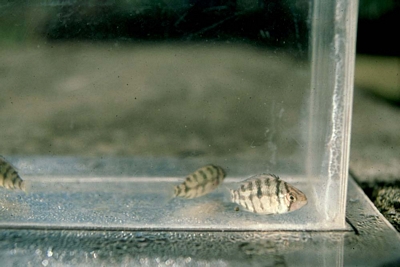 |
Small Mazarunia mazarunii in the phototank. |
Mazarunia mazarunii was described by Dr Kullander in January 1990 and it's a new genus and species from Guyana, South America. The fish was already collected by a friend of mine, Dr Patrick de Rham in 1976, but the description was postponed since only two specimens were collected. The description was done in `Ichthyological Exploration of Freshwaters'.
I decided to go to Guyana in October 1999 and one of the goals with the trip was to see if I could manage to find and collect Mazarunia mazarunii. I will not tell you here about the whole trip in Guyana, which was a very nice trip, but concentrate on Mazarunia.
We had to charter a small, five-seat plane, to get up to Kamarang and Mazaruni River, and it cost us US$613. Kamarang is an Ameroindian Camp and to go there you need a permit from the Internal Office. We did not have that and had problems with the local police, who kept asking us for our documents. But I will not bore you with that and only tell you that we managed to get one day out and I managed to collect Aequidens potaroensis, Cichlasoma bimaculata, Mazarunia mazarunii and maybe a new Mazaruni sp. I'm not sure if it's a new Mazarunia or a new Genus, I have to wait to see what Dr Kullander says.
We went down the Mazaruni River for about an hour and made camp at a place called "Pepper Camp". The next morning we crossed the river to a small river/creek called Kanawee Creek.
The biotope in Kanawee Creek where I collected my Mazarunia. |
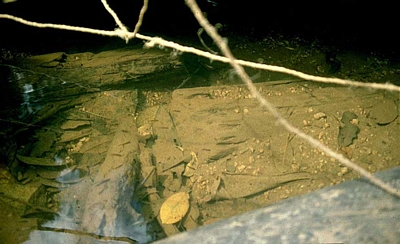
|
The water there was rather cold, but clear. I managed to collect 10 Mazarunia mazarunii, Aequidens potaroensis and some Cichlasoma bimaculatum.
The water parameters were: Water temperature 21.7°C, air temperature was 27°C, pH was 6,5, dH was 2 and the time was 09:00. The position was 06°00'04"N and 60°37'47"W. I was in the water for an hour, then I started to feel freezing and had to get up and sit in the sun to get warm.
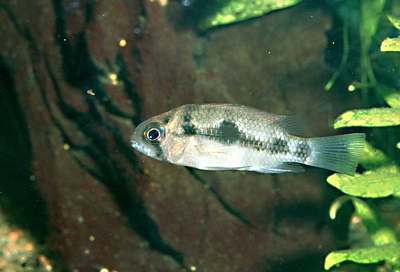 One of the small Mazarunia brought back home.
One of the small Mazarunia brought back home. |
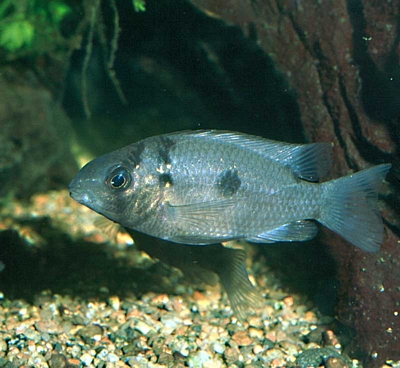
An adult male Mazarunia mazarunii in a good mood. |
Back home I placed the fish in a 100-liter tank and feed them with live Artemia, Cyclops, frozen red mosquito larvae and a good-quality flake food. The fish were slowly growing up to adult size that was between 5-6 cm. The males were a little bigger than the females.
You could not say that the fish is very colorful, but in the grey color and with special black markings when they are in breeding color they are very nice fish.
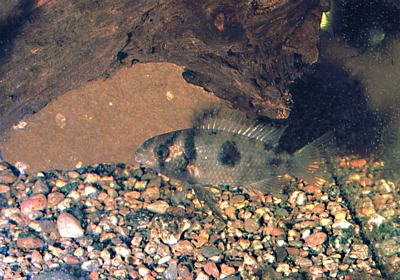 Feeding a lot with Artemia.
Feeding a lot with Artemia. |
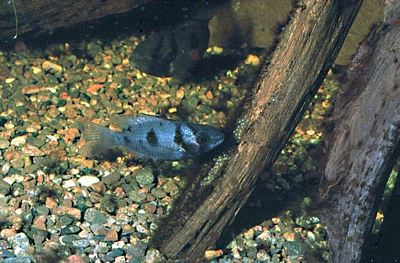
Female guarding eggs laid on the root. |
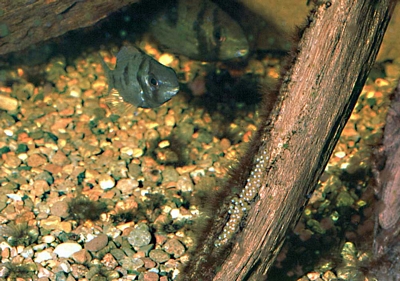 When I came with my camera, the fish stood in the background watching what I was doing.
When I came with my camera, the fish stood in the background watching what I was doing. |
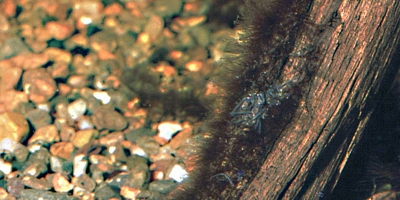
Freshly hatched fry with yolk sacs, hanging on the root.
|
In my tank with several spawnings, they chose a vertical side of a piece of log. Eggs were rather small and the number of fry was not many. The largest number of fry I have had so far is 12. I don't know the reason for this. The small fry or eggs could have been eaten by some Ancistrus in the tank or other adult Mazarunia could have eaten some. But anyhow, I did manage to breed them and have also been able to spread them around to some friends.
The pair guarding the eggs. |
|
For more scientific information, I suggest you read Dr Kullander's description: `Mazarunia mazarunii (Teleostei: Cichlidae), a new genus and species from Guyana, South America.' Ichthyological Explorations of Freshwater. Vol. 1, pp3-14, January 1990.
I also managed to collect a fish that might be a new Mazarunia, but I don't think they look much alike. You can look at the photo and see what you think.
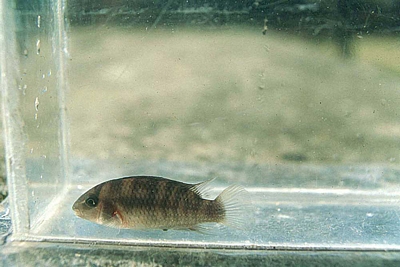 |
The Indians in Kamarang called this fish "Red Patwa".
It has already been bred, but so far not scientifically described.
|
This page was not so big, but there is only one fish described in this genus. The Red Patwa is not yet described, and I think it will be put in a new genus.